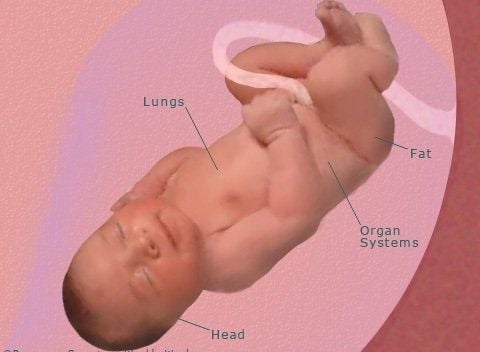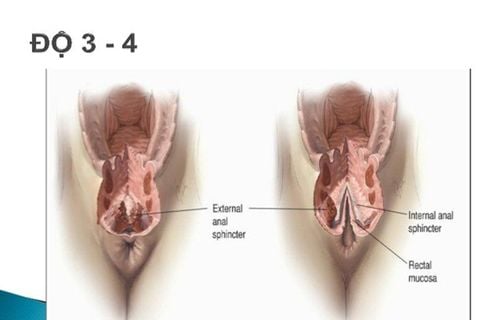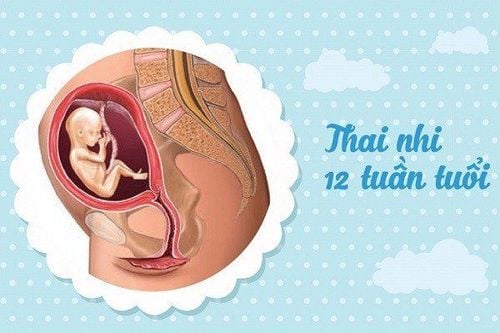This is an automatically translated article.
The article is professionally consulted by Doctor Department of Obstetrics and Gynecology, Vinmec Hai Phong International General Hospital.
Fetal development at 39 weeks, or 37 weeks after conception, is evident in the baby's increasingly distended chest. In boys, the testicles continue to move down into the scrotum. The 39-week fetus kicks a lot from now until the day of birth.
1. The development of the fetus at 39 weeks
The pregnant woman is in the 9th month of pregnancy, if it is as expected, only 1 or 2 more weeks until the pregnant mother will be able to meet her baby. However, the fetus is also ready to be born any day from this point. Usually, a full pregnancy is between 39 - 40 weeks. Babies born before 37 weeks are born preterm, from 37 to 38 weeks are born early, 41 weeks are born late, and those born after 42 weeks are born late. Therefore, the baby will be considered full-term when starting to enter 39 weeks.
Baby's size is now about the size of a watermelon, with a length of about 50.1cm and a weight of 3,186 kg. In particular, the head of the fetus accounts for about one-third of the total weight. How much a baby weighs at 39 weeks depends on the baby's sex. In general, boys will tend to weigh a few pounds more than girls.
39 weeks pregnant will have the following changes:
Baby accumulates fat and gets fat: The development of the 39-week fetus is physically complete at this point, but baby will continue to gain weight. A layer of fat covering the whole body of the fetus is accumulated thicker to keep the baby warm after birth, ensuring good temperature regulation to adapt to the environment outside the mother's womb.
Baby's brain thrives: While the baby's body is not changing as much as before, the brain is still continuing to develop at an amazing rate. In just the past 4 weeks, the fetal brain has grown by 30%. This rate of development will continue for the first 3 years of life, as shown in the new skills your baby learns and performs every day.
Fetal crying in the womb: There are cases where a pregnant mother in the last month hears the baby's cry, especially at night. Although science has not yet explained this phenomenon, in fact, at this stage, the baby's tear glands are not active and there will be no tears shed. All the baby can do is rub his eyes with his hands similar to crying, and you will see this in the ultrasound video.
Fetal skin:

Newborn skin may appear pinkish red, because blood vessels under the skin are seen through the delicate epidermis. Chubby babies often have white skin because the subcutaneous fat layer is thicker. However, the fetal skin is also likely to be pale or purple because the circulatory system is not yet active and the baby is still lacking blood and oxygen. After birth, skin pigmentation will resonate with the outside environment to form the baby's real skin color, which can be lighter or darker. Babies with mild jaundice are a normal physiological phenomenon, severe and prolonged levels are at risk of pathology.
Trắc nghiệm: Bạn có hiểu đúng về dấu hiệu mang thai sớm?
Các dấu hiệu mang thai sớm không phải chỉ mỗi trễ kinh mà còn có rất nhiều dấu hiệu khác như xuất huyết âm đạo, ngực căng tức,… Điểm xem bạn biết được bao nhiêu dấu hiệu mang thai sớm thông qua bài trắc nghiệm này nhé!
39 weeks fetus kicks a lot: The mother should pay attention to the baby's movements and notify the obstetrician if she does not notice the 39-week fetus kicks a lot. Babies will be quite active between now and birth, so a noticeable slowdown in activity could be a sign of an unusual problem.
Baby has not turned its head (breast position / breech birth): If at this stage, the fetus still has not turned its head, the midwife will support and guide the mother to perform some specific exercises to help the baby rotate the head. , limiting the need for caesarean section. You can refer to the pelvic tilt exercise, or kneel, spread your legs, then bend down so that your chest and abdomen touch the floor, repeat the movement 3 times a day. Details of the fetus's development week by week, Every parent should learn:
2. Notes in week 39 of pregnancy
It is very important to recognize the signs of labor during these perinatal days, including some of the following:
Water breaks: May be large flow or only mild leakage of amniotic fluid; Gastrointestinal disturbances: Diarrhea or nausea is likely to occur before labor begins; Instinct "nesting": The appearance of a great source of energy motivates the mother to get ready to welcome the baby. Loss of the mucus plug: A mucus plug that seals the mother's uterus may be removed through testing for uterine dilation; Vaginal bleeding: Cervical capillaries rupture due to dilation and spill blood, causing vaginal discharge to be pink or tinged with red.

Sharp pain from the vagina to the legs: Don't be too worried when sometimes the mother will feel this pain because the fetus presses on the pelvic nerve; “Fake” pain: You may notice more Braxton Hicks contractions as you prepare for labor, requiring immediate medical attention if the contractions are more frequent and intense. When the fetus is 39 weeks pregnant, this is also the time when the mother's intestinal tract is compressed quite a lot, the uterus stretches, making the pregnant belly heavier and heavier. Moreover, the 39-week fetus kicks a lot and moves close to the pelvic area also increases the level of pain. Mothers can refer to some physical therapy methods such as acupressure and massage to relax both physically and mentally, waiting for the important day to come. Don't forget to have your bag ready and prepare the necessary skills for the first time of labor, birth and breastfeeding. Especially, in the last 3 months of pregnancy, the health of both mother and baby needs to be closely monitored and checked. Pregnant women need:
Know the real signs of labor to get to the hospital in time, affecting the health of the fetus. Differentiate between amniotic fluid and vaginal discharge for timely handling to avoid premature birth, fetal distress, and stillbirth. Be especially careful when bleeding in the last 3 months of pregnancy needs urgent emergency care to ensure the life of both mother and baby. Monitor the amount of amniotic fluid regularly and continuously. Monitor fetal weight in the last 3 months to assess baby's development and predict possible risks at birth. The special monitoring group is the same as the striker, and the fetal growth retardation needs to be closely monitored by the doctor and given appropriate indications. Distinguish between physiological contractions, labor contractions and mechanical pregnancy to get to the hospital in time. Maternity services at Vinmec make the pregnancy process easier and safer for pregnant women. During pregnancy, pregnant women will be examined by top doctors in the Obstetrics and Gynecology Department with high professional qualifications and experience, giving the best advice and treatment for the health of both mother and child. little.
For detailed information about all-inclusive maternity service packages, please contact the hospitals and clinics of Vinmec Health system nationwide.
Please dial HOTLINE for more information or register for an appointment HERE. Download MyVinmec app to make appointments faster and to manage your bookings easily.
Reference source: Webmd.com, Mayoclinic.org
Recommended video:
Instructions for rolling a blanket for babies, helping them have a good night's sleep













